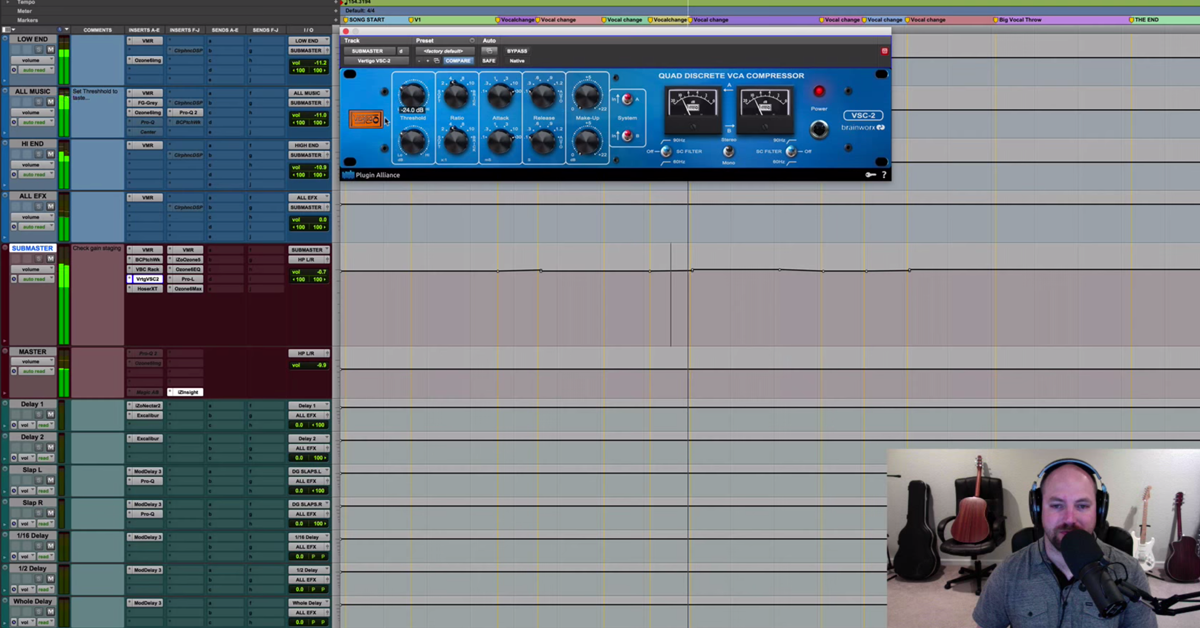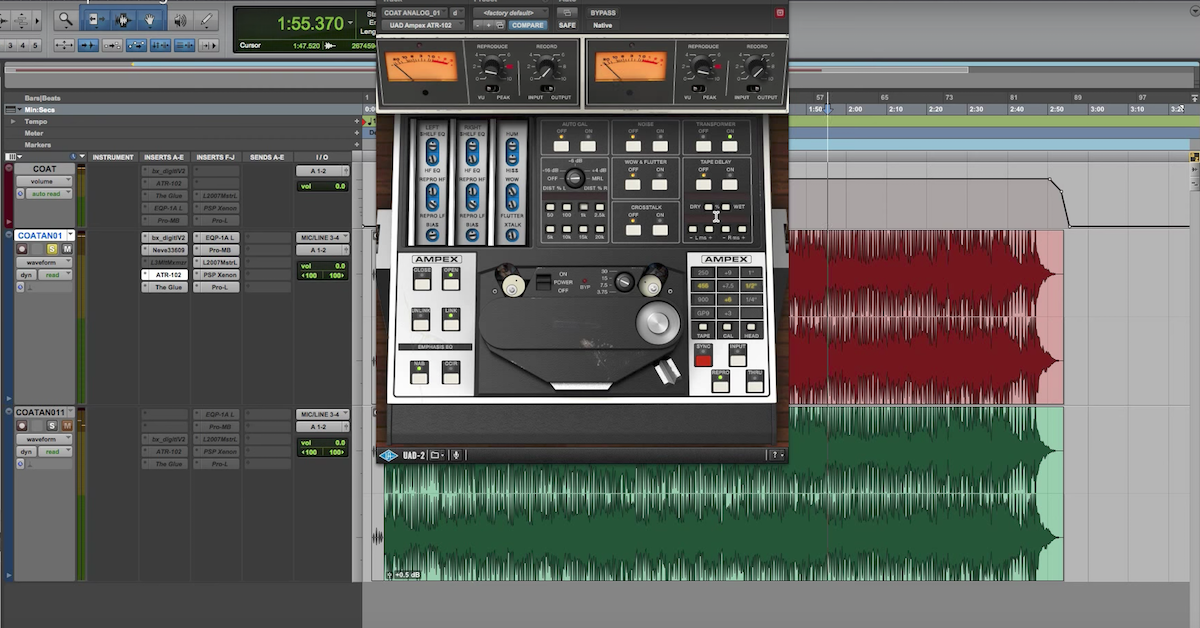Stereo Buss Compression — Why I Do It
Stoked to have you today. I’ve got a pretty controversial topic in front of us. We’ve got the stereo buss, yet again. If you haven’t seen my stereo buss master class, feel free to go check that video out first. I would say the three most common questions that I get are, one, “will you listen to my mix, let me know where I’m at,” two, vocals. Anything to do with vocals. Then three, the stereo buss. In no particular order, I love talking music. I love talking mixing. Stereo buss is a fun one. It’s kind of a personality trait. You know, if you’re familiar with the mix buss and the stereo buss, it’s what everything passes through before the final print. It could be hardware, it could be outboard gear, it could be plug-ins, or nothing.
It’s a total taste thing. If you like it, don’t like it… By all means, I don’t preach that this is what you should do, I just present a lot of the things that I do and say, “hey, here are some options. Here are some things that work for me.” If you like it, copy it. Use it, tweak to taste. By all means, you can have a stereo buss and be cool. You can ignore and have nothing on your stereo buss and be cool. This is not anything that is a set rule. By all means, do what you want to do.
But I did want to show a little example. It might not be the best comparison, but I have a friend over at themixacademy.com, and he’s a member, and he sent me his mix for December. Not really a mix, but a version of his song, of his mix, where all he did for the mix was pull up a rough mix, and apply Slate VMR’s Revival, and he did that on every single track, and he sent that to me, and I was like, “You know, that’s a pretty interesting thing to do.” Revival is a great plug-in. It adds top, it adds bottom. It has some character, some mid-range, some analog emulation stuff going on. The modeling is there. Fun, you know? We like to do shoot outs. Well, I’m going to take his example and his test, and I’m going to throw it in. I’ve duplicated it, I’ve limited it on one track. I’ve done nothing but put Ozone and pull the limiter down so that it was at the same RMS value or LUFS volume value as a duplicate. The duplicate, I ran through my 2-buss, and then I’m going to show you if I bypass the plug-ins, what it sounds like, when I put them in what it sounds like, and this will just be a fun little A/B/Y test and we’ll see what we think.
So moving ahead, I’m going to hit play. The first example up here – let me make that inactive. This first example is his mix with nothing on it. Let’s bypass the limiter.
[music, no limiter]
Okay. Now, there’s no compression. There’s no EQ. There’s nothing. This is simply limited, and like I said, he mixed it with Revival.
[music with limiter]
Okay, so we’re reducing the dynamic range a little bit. We’re limiting it just to get it up to volume, because I want to compare it and give somewhat of a proper comparison to my version over here.
Now, I didn’t mix this. This isn’t something that I did. I’m simply duplicating his Revival mix, and running it through my 2-buss so we can hear the difference. A couple of things to note before I hit play, is I didn’t mix through the two-buss. He didn’t mix through my mix buss. There’s decisions that you’ll make when you mix through plug-ins or through outboard gear on your stereo buss. They’re decisions that you’d make differently against if you don’t use it.
So, kind of like I said. A failed test from the beginning, but it’s still fun to see what it sounds like. So here we go, I’m going to hit play, and we’re going to take an A/B on it.
[song plays going through mix buss processing]
And then the original.
[song plays with/without two-buss processing]
Okay, so it sounds cool. There’s a difference for sure. I like the openness of the original without the extra compression, but like I said, I probably wouldn’t compress as much if I’m mixing through my 2-buss as if I’m not.
So that’s the first thing I noticed. I felt like there was compression going on, obviously. It was wider. Why? Well, I have a widening plug-in on my 2-buss that pushes things out 5-10%, and then I’ve got Slate’s Virtual Mix Buss here, and the SSL seems to push things out a little wider already, so there’s some character coming in there. There’s the S1 pushing it out about 10%, and then you’ve got harmonic character from the UAD emulations. No compression, no EQ happening. It’s just modeling the character.
Then moving away from that stuff, it goes into – just kind of a quick overview of where I’m at now, the Virtual Buss Compressors, I’ve got the FG-Grey. No compression happening at all, it’s just a character. Same down here, it’s kissing the needle a little bit. A slower attack, faster release. Just kind of hitting the needle barely. Take a listen if I bypass this one. I’ll hit play and then bypass this plug-in alone.
[song plays, disabling and re-enabling VBC]
Okay, so there’s definitely a volume difference just from bypassing it. However, you’ll hear the midrange pops out more with this engaged. So, I’m mixing through that and I feel like I have to work less with my mid-range when I’m doing that. It’s not an end all, put a 2-buss and mix into that and you’re going to be a professional mixer. That’s not how it works, but hopefully you’re smart enough to get that while watching this video. This isn’t a solve all your problems type of situation.
Then I’ve got the multiband compressor, straight out of the Pensado ITL world of the Hip Hop basic preset from Ozone 5, and I just kiss this a little bit to reduce some low-end, the low mids, they just get hit a little bit to control those. But I’m again mixing through this from the beginning, and tweaking it as I go.
The Pro-L from FabFilter is doing just a little bit of reduction. Probably not even anything crazy.
[song plays]
Yeah, it’s hitting it just a little bit. Give it a little lift. And then it’s going into VMR, which is on my two-buss now. VMR is pretty substantial. Let’s listen to that before and after.
[song plays, before and after VMR]
Yeah, so the shimmer knob gives it some serious life. It’s obviously boosting the top end, so you’ve got to be careful how much you boost. That’s just what my default 2buss is set to. So I’m mixing, again, through this plug-in from the very beginning, and I’m having to boost less top end because of mixing through it. Then a little bit of thickness, because I like the color that it adds. It’s all subtle, pretty subtle stuff. The shimmer, probably that and VBC are probably the most dramatic differences.
And then, my maximizer that is sometimes set a little bit lower. It just depends from the get-go. Then let’s use this as an example of if I now hit play and I bypass each one of those plug-ins, listen to the cumulative effect that each of them are adding.
[music, bypassing mix buss plug-ins.]
Okay, so that’s off completely, and now listen to the difference if I put this back at zero, you’ll hear these are the exact same track.
[music, alternating between the two tracks]
Exact same duplicate. Totally different vibes. I would be willing to say that the one going through the 2-buss is more full, it’s got a little bit more of a cleared up mid-range, it’s got some control with the compression. It does have less dynamic range. My end goal is usually around -7, -8, -9 depending on the style of music and what I can convince the client of for LUFS. I try to go more conservative, but things in the industry right now tend to be a little hotter, so it all depends.
This is totally a taste thing, man. Have fun with it. On my 2-buss, I’ll also say that I’ve got multiple busses that I have, where drums get parallel compression, a lot of times, the music gets SSL compression, the top end, the bottom, all of those are split out on stereo busses – not stereo busses, but pre-stereo buss busses. Stereo aux tracks on Pro Tools. I’ll treat them with a little bit of compression before it hits the 2-buss, so this isn’t even a proper comparison of what I would open up and do a rough mix.
So, tell you what. I’m going to pull open raw, dry tracks. I’m going to mix them through with nothing on them, and do a rough mix, just balancing levels through my stereo auxes, and then my stereo buss, and then we’ll get a really great comparison of what it would sound like with and then without starting your mix with a 2-buss similar to mine, so.
Hope you guys dig that. A little bit of fun. Don’t forget to check out davidglennrecording.com. There’s two free courses, and another one that will be added soon. Davidglennrecording.com, you can download those when you become a subscriber. Themixacademy.com for just $27 a month. Go check that out, you’ll be blown away. I think you’ll love it. Then theproaudiofiles.com for all of the incredible content that waits for you over there.
If you dig this video, you think it would help somebody, it would open up their mind creatively to experimenting on the 2-buss, maybe some producers or engineer friends of yours. Feel free to share it with them, we’ll thank you for it, and it helps us to continue to bring you great content, so we’ll catch you guys in the next video.
Thanks again!





